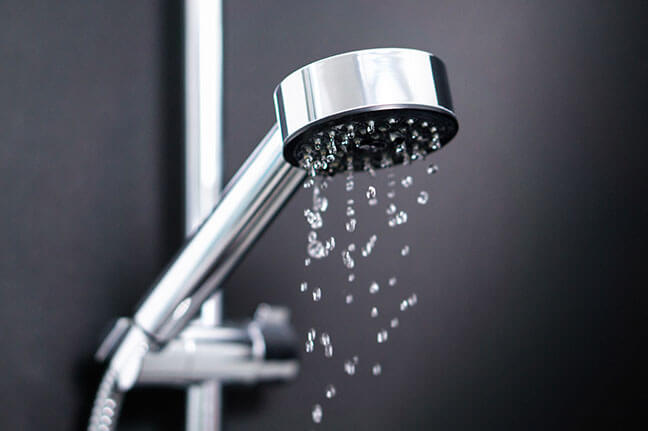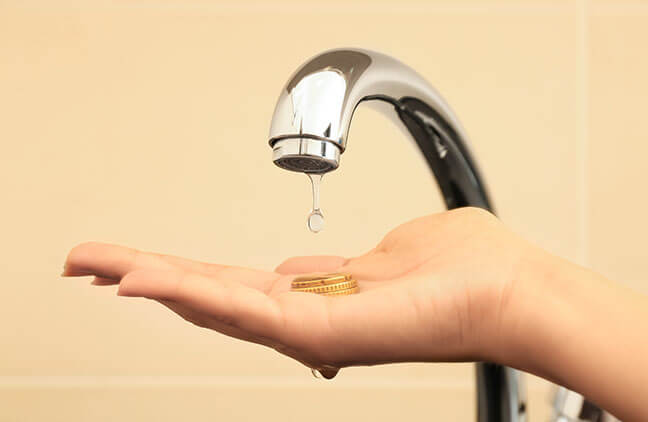Tired of Getting Soaked by High Water Bills? Try These Simple Tricks to Start Saving
Is your wallet shrinking every time your water bill shows up? Don’t despair – with a few easy changes, you can reduce your water usage and stop drowning in high utility costs.
This article will walk through 12 money-saving tips that can cut your water bill dramatically. From finding hidden leaks to adjusting daily habits, these practical steps can make a big splash in lowering your monthly water expenses. Read on to start saving!
Detect Water Leaks Around Your Home
One of the sneakiest sources of water waste is easily overlooked leaks. A small, unnoticed drip from a worn washer or pipe fitting can waste hundreds of gallons of tap water over time. Take time to thoroughly inspect for leaks to avoid this unnecessary water loss.
According to the Environmental Protection Agency, “The average household’s leaks can account for nearly 10,000 gallons of water wasted every year and ten percent of homes have leaks that waste 90 gallons or more per day.”
How to Check for Leaky Taps and Pipes
Carefully examine all plumbing fixtures, pipes, and water-using appliances inside and outside your home. Look for wet spots, moisture, or mineral deposits that may indicate a leak. Don’t forget to check irrigation systems and spigots too.
To pinpoint tricky leaks, monitor your water meter overnight or for a few hours when no water is being used. Movement on the meter during this period signals a leak somewhere. Act quickly to repair any drips or leaks detected – this can save thousands of gallons annually!

Install Water-Efficient Fixtures
Replacing old, inefficient faucets, showerheads, and toilets with new WaterSense labeled models can dramatically reduce water usage. These fixtures deliver the same performance while using 20% to 60% less water, according to EPA estimates.
Low-flow toilets are a top water-saving upgrade – installing one can conserve thousands of gallons per year. Water-efficient faucet aerators and showerheads also offer major savings without sacrificing experience. Look for the WaterSense logo when shopping for any new plumbing fixture or appliance.
The installation process is typically simple with basic tools. Make this easy upgrade today and watch your water use decline!
Adjust Daily Water Use Habits
Small changes in how your household uses water day-to-day can make a surprising difference. Conserve simply by turning off faucets when not in use, taking shorter showers, and only running full loads of laundry and dishes.
Take Shorter Showers
Cutting just a few minutes off your regular shower time can make a surprising dent in your water usage over time. According to the EPA, a typical 8-minute shower uses about 17 gallons of water.
Reducing your shower by just 2-3 minutes could save up to 5 gallons per shower. For a household taking four 5-minute showers per day, the gallons saved could add up to over 700 gallons per month! With the average cost of water around $2 per 1,000 gallons, that small change could reduce your water bill by around $1.40 per month.
Every drop counts, so challenge yourself to shave a few drops of time off your regular shower routine. Both your water usage and wallet will thank you.
Turn the Faucet Off When Brushing Your Teeth
Leaving the water running while you brush can waste a surprising amount of water. The average faucet flows at 2 gallons per minute. Brushing your teeth twice a day with cold water on the whole 2 minutes uses over 120 gallons per month per person!
Change Your Dish Washing Habits
How you wash dishes impacts your water bill. Hand-washing dishes uses about 20 gallons of water per load. But an Energy Star dishwasher uses just 3-4 gallons per load.
Run full loads only. Scrape food scraps – no need to pre-rinse. If you must wash a partial load by hand, fill one sink or basin with wash water and the other with rinse water. Reuse wash water for cleaning multiple loads.
Compared to hand washing, using a water-efficient dishwasher for just one load per day could save around 8,000 gallons annually!
Only Run a Full Load in the Washing Machine
Only run full loads in your washing machine to maximize efficiency and savings. Today’s washing machines only use 20-40 gallons of water per full load. But running a half-load uses over 50% as much water as a full one!
Washing four half-load cycles per week rather than two full ones uses an extra 160 gallons monthly. For the average family that does four loads per week, that’s nearly 2,000 more gallons yearly. At an average water rate of $2/1,000 gallons, cutting half-loads could save around $4 per month or $48 annually.
As an added bonus washer with high-efficiency energy star seals helps you save money on your electricity bill as well.

Trick Your Toilet Tank
Here are three tips for using plastic soda bottles or bricks to trick your toilet tank into conserving water and using less water per flush:
- Place two plastic soda bottles filled with water or sand inside the tank. Position them away from any moving parts. This displaces water in the tank, so less is used with each flush. Just be sure the bottles don’t interfere with the flushing mechanisms.
- Put a toilet tank bank or float booster in the tank. These devices take up space so less water is needed to fill the tank between flushes. Look for a tank bank designed specifically for your toilet model for the best fit.
- Add a toilet tank displacement bag. These reusable bags fill with water and expand in the tank to reduce the water volume. Make sure to get a size that fits your tank properly.
The key is to replace some water volume with bottles, bricks, or devices. This tricks the tank into thinking it’s full, while still using less with each flush. Just be careful not to over-displace water or it can cause flushing issues. Aim to save 1-2 gallons per flush for optimal water savings.
Maximize Outdoor Watering Efficiency
Outdoor watering often accounts for the biggest chunk of residential water consumption. Make sure every drop spent on watering plants, lawns and landscaping goes the distance by using smart watering methods.
Water in the early morning or evening when evaporation is lower. Inspect sprinklers regularly and aim them to avoid wasting water on paved areas. Let your grass grow taller – longer blades promote deeper roots and retain moisture better.
Choose native plants suited for local conditions – they require far less water than other varieties once established. Simple practices like these can transform your irrigation habits to maximize efficiency.
Upgrade Home Irrigation Systems
Improving your irrigation system offers an easy route to save water. One simple upgrade is installing WaterSense labeled smart controllers that automatically adjust watering times and frequency based on weather and plant needs.
Low-flow drip irrigation and sprinkler heads also deliver dramatic savings by slowing water flow. Captured rainwater from a rain barrel provides a free and naturally soft source for irrigating lawns and gardens.
Consider xeriscaping by replacing turf grass with low-water native plants for a beautifully water-wise landscape. Small investments in efficiency yield huge savings.
Allow grass and plant growth to go an extra couple of days before cutting or trimming. The longer plants will hold soil moisture and reduce evaporation.
Get Help Paying Your Bill Through LIWAP
If high water bills are causing financial hardship, the Low Income Water Assistance Program (LIWAP) provides aid in paying water and wastewater costs. LIWAP offers federal grants administered through states to help qualified households.
LIWAP assistance is based on income, household size, and water costs. Eligible applicants must have an income below 60% of the state median and meet requirements. To apply, contact your local LIWAP agency. Receiving aid through LIWAP helps ensure continued access to safe drinking water and sanitation.
Research Other Water Bill Assistance Programs
Along with LIWAP, other local, state, or Federal programs may offer financial assistance or resources related to water efficiency. Research what specialized water bill help may be accessible in your area.
Search “[your location] water bill assistance program” or “[your state] water efficiency programs.” Nonprofit organizations and public utility providers also sometimes have support options available – reach out to them directly to inquire. Discover what savings are possible!
Leverage ACP Savings for Water Costs
The Federal Affordable Connectivity Program (ACP) provides monthly discounts on internet and cell phone bills for qualifying households. Over 40% of US households are eligible based on income guidelines.
Sign up with Easy Wireless to get a SIM Card Kit shipped to your door with FREE Monthly Unlimited Talk, Text, and Data after being approved for ACP.
Turn this monthly wireless savings into a fund for your water bill or invest it back into water-saving home upgrades like low-flow fixtures. With EASY, Wireless saving money is easy!
It only takes a couple of minutes to sign up and qualify for FREE Wireless Service.
Start Saving Today!
Start Saving Today!
Slash Your Water Bill Today!
It doesn’t take a huge effort or expense to start saving money on your water and help the environment and your community when you conserve water. Begin with easy no-cost steps like finding and fixing leaks or adjusting daily habits around sinks and showers. Bigger upgrades to water fixtures, outdoor irrigation, and landscaping deliver even more savings over time.
Along with conservation, tap into financial assistance programs like LIWAP or leverage wireless subsidies from ACP providers like EASY Wireless to free up more money for your water costs.
Put these practical tips into action to keep more money in your pocket this year. Start waving goodbye to wasted water and whopping bills! Which tip will you try first?


